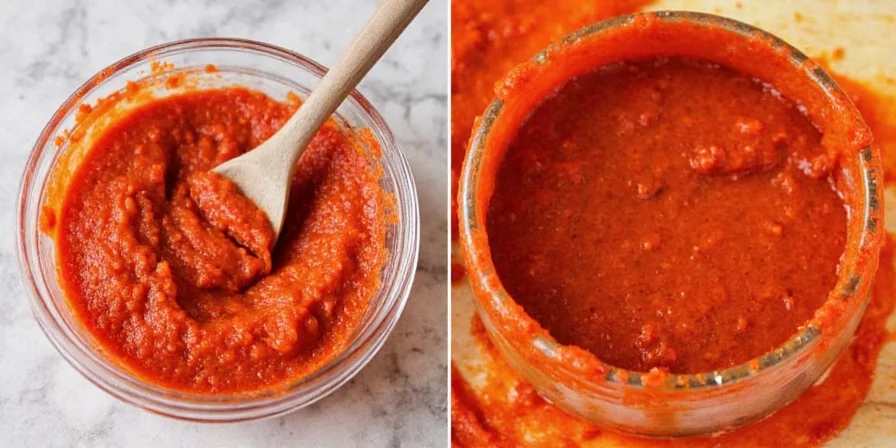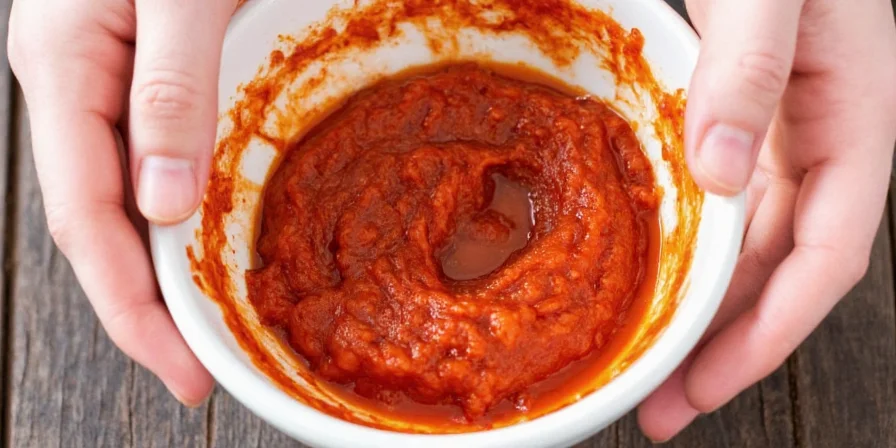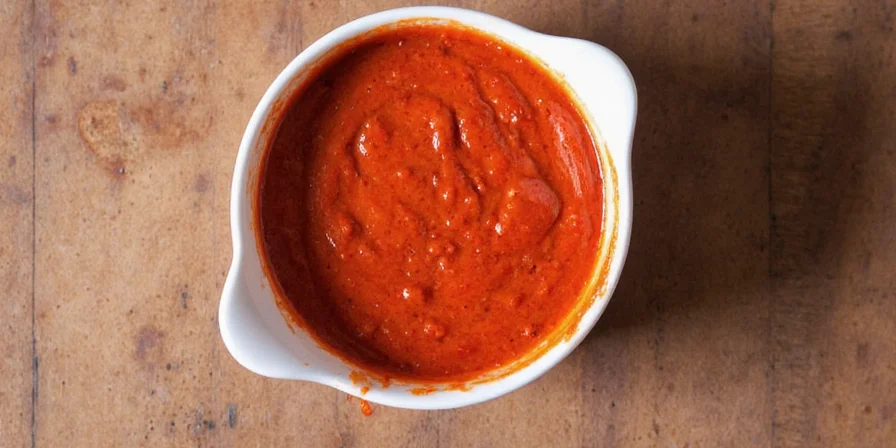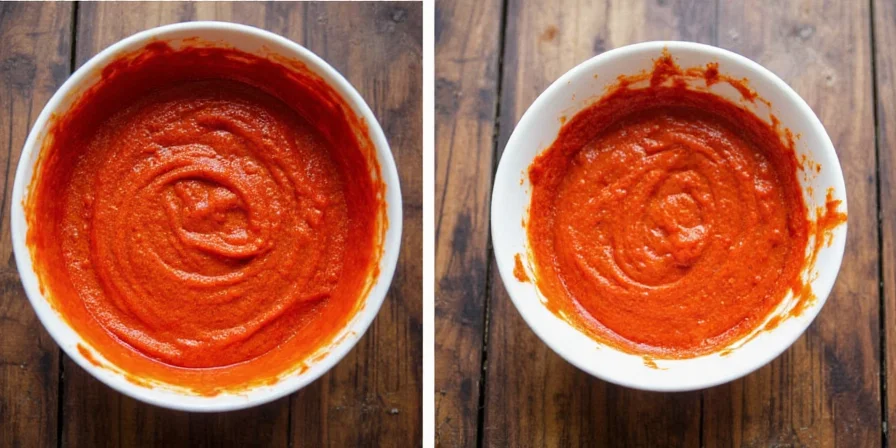Looking for how to make authentic gochujang at home? This guide provides both a simple traditional recipe and advanced scientific techniques for perfect Korean chili paste. Start with our beginner-friendly method (takes 10 minutes to prepare), then explore our temperature-controlled fermentation protocols if you want to elevate your results. Discover why homemade gochujang tastes better than store-bought, how to avoid common mistakes, and creative ways to use it in everyday cooking.
Table of Contents
- What Is Gochujang and Why Make It at Home
- Simple 5-Ingredient Gochujang Recipe (Ready in 10 Minutes)
- Why Store-Bought Gochujang Lacks Flavor
- Advanced Fermentation Method for Artisanal Quality
- Choosing the Right Ingredients: What Most Guides Miss
- Temperature Control for Better Flavor Development
- 10 Creative Ways to Use Gochujang Beyond Korean Dishes
- Proper Storage to Maintain Freshness
- Troubleshooting Common Problems
- Frequently Asked Questions
What Is Gochujang and Why Make It at Home
Gochujang (고추장) is a thick, savory-sweet Korean chili paste made from fermented red chili powder, glutinous rice, and fermented soybeans. Unlike basic hot sauces, authentic gochujang develops complex umami flavors through natural fermentation. Homemade versions taste noticeably better than store-bought because commercial brands often use shortcuts like preservatives and artificial flavors that prevent true fermentation.
When you make gochujang at home, you get:
- Richer, more balanced flavor without artificial additives
- Customizable heat level and sweetness
- Fresher taste with no preservatives
- Authentic texture that's smooth but not gummy

Simple 5-Ingredient Gochujang Recipe (Ready in 10 Minutes)
Perfect for beginners, this quick version skips lengthy fermentation while still delivering authentic flavor. Makes 1 cup.
| Ingredient | Amount | Substitute Options |
|---|---|---|
| Korean red pepper flakes (gochugaru) | ½ cup | ¼ cup paprika + ¼ cup cayenne (less authentic) |
| Sweet rice flour | ¼ cup | All-purpose flour (texture will be different) |
| Rice syrup or honey | 3 tbsp | Maple syrup or brown sugar |
| Soybean paste (doenjang) | 2 tbsp | Miso paste (closest substitute) |
| Garlic, minced | 1 tbsp | ½ tsp garlic powder |
- Mix rice flour with ½ cup water in saucepan. Cook over medium heat, stirring constantly until thickened (about 5 minutes).
- Remove from heat. Stir in remaining ingredients until smooth.
- Cool to room temperature, then transfer to jar. Refrigerate for 3 days before using for best flavor.
- Store in refrigerator for up to 3 months.
Why Store-Bought Gochujang Lacks Flavor
Most commercial gochujang brands cut corners that compromise flavor:
- Added preservatives prevent natural fermentation
- Artificial sweeteners mask incomplete flavor development
- Thickeners like xanthan gum create fake texture
- Short aging periods (most brands age 6 months vs traditional 12-24 months)
The good news: even our basic 10-minute recipe tastes better than store-bought versions because it uses real ingredients without additives. For even better results, try our advanced fermentation method below.
Advanced Fermentation Method for Artisanal Quality
For serious home chefs who want truly authentic gochujang, this controlled fermentation process develops deeper flavors through natural enzymatic reactions. This method requires more time but produces noticeably superior results.
- Starch Preparation: Heat rice flour mixture to 62°C (143.6°F) for 20 minutes to activate natural enzymes
- Initial Mix: Combine with gochugaru, rice syrup, and traditional meju culture at 45°C (113°F)
- Primary Fermentation: Maintain at 30°C (86°F) for 7 days for sugar development
- Flavor Development: Lower temperature to 22°C (71.6°F) for 60+ days
- Maturation: Store at cool room temperature (12°C/53.6°F) for 3-6 months

Choosing the Right Ingredients: What Most Guides Miss
Ingredient quality makes a huge difference in final flavor. Here's what to look for:
| Ingredient | What to Look For | Why It Matters |
|---|---|---|
| Red chili flakes | Bright red color, 8-10% moisture | Too moist causes spoilage; too dry reduces flavor development |
| Sweet rice flour | Finely ground, pure white | Proper starch structure creates ideal texture |
| Rice syrup | Clear, mild sweetness | Better than sugar for supporting fermentation |
| Doenjang (soybean paste) | Earthy aroma, no off smells | Provides essential fermentation cultures |
Temperature Control for Better Flavor Development
Temperature directly affects which flavors develop during fermentation:
- 28-32°C (82-90°F): Creates sweeter gochujang (ideal for first week)
- 22-25°C (72-77°F): Develops savory umami flavors (best for weeks 2-8)
- Daily temperature swings: Mimics traditional clay pot fermentation, creating more complex flavors
Pro tip: If you don't have a fermentation chamber, place your gochujang in a cooler with a temperature-controlled reptile heater mat for consistent results.

10 Creative Ways to Use Gochujang Beyond Korean Dishes
Don't limit gochujang to Korean recipes! Try these easy applications:
- Marinades: Mix 2 tbsp gochujang with 1 tbsp soy sauce and 1 tbsp honey for perfect grilled chicken
- Salad dressings: Whisk 1 tbsp gochujang with 3 tbsp rice vinegar and 2 tbsp olive oil
- Stir-fry sauce: Add 1-2 tsp to your favorite vegetable stir-fry
- Pizza sauce: Substitute for tomato sauce (mix with olive oil for better spreadability)
- Deviled eggs: Mix with yolk filling for spicy twist
- Mayonnaise boost: Stir 1 tsp into mayo for sandwiches
- Roasted vegetables: Toss with 1 tsp before roasting
- BBQ sauce: Mix 2 tbsp with ½ cup BBQ sauce
- Gravy: Add to pan drippings for Thanksgiving turkey
- Cocktails: Small amount in Bloody Mary mix adds depth

Proper Storage to Maintain Freshness
How you store gochujang affects both shelf life and flavor development:
- Refrigeration: Store in airtight container for up to 6 months (flavor continues to develop)
- Freezing: Portion into ice cube trays, then transfer to freezer bags for up to 1 year
- Room temperature: Only safe during active fermentation (first 3 months)
- Signs of spoilage: Mold on surface, sour smell, or dramatic color change
Troubleshooting Common Problems
Fix these common issues with simple solutions:
| Problem | Quick Fix | Prevention for Next Time |
|---|---|---|
| Too spicy | Add honey or rice syrup (1 tsp at a time) | Use milder chili flakes next time |
| Too thick | Mix in water or rice vinegar (1 tsp at a time) | Add more liquid during initial mixing |
| Sour taste | Add 1 tsp honey, let sit 24 hours | Maintain proper fermentation temperature |
| Mold on surface | Remove top layer, add ½ tsp salt | Ensure proper salt ratio (3.5-4%) |
| Bland flavor | Let sit in refrigerator 1-2 weeks | Ferment longer next time (60+ days) |
Frequently Asked Questions
Whether you're making gochujang for the first time or perfecting your technique, this guide gives you everything needed for authentic results. Start with our simple 10-minute recipe that outperforms store-bought versions, then experiment with our temperature-controlled fermentation method when you're ready to take your skills further. With these techniques, you'll create gochujang with richer flavor, better texture, and no artificial additives - perfect for elevating everyday meals with authentic Korean taste.











 浙公网安备
33010002000092号
浙公网安备
33010002000092号 浙B2-20120091-4
浙B2-20120091-4